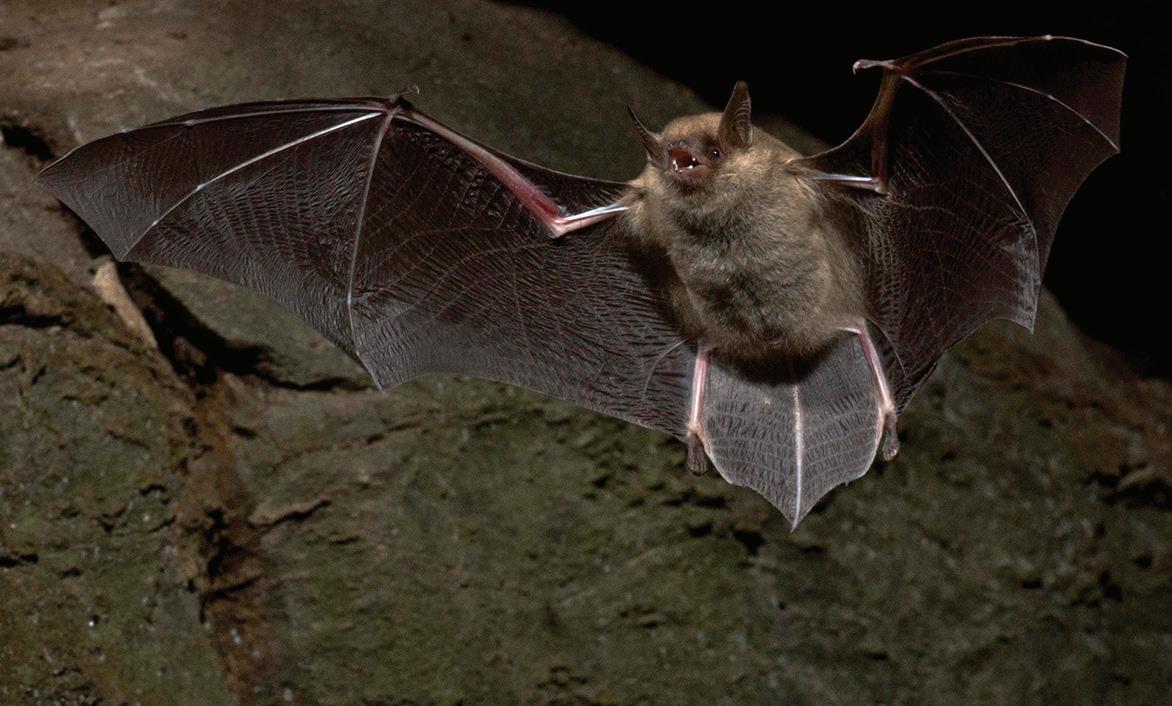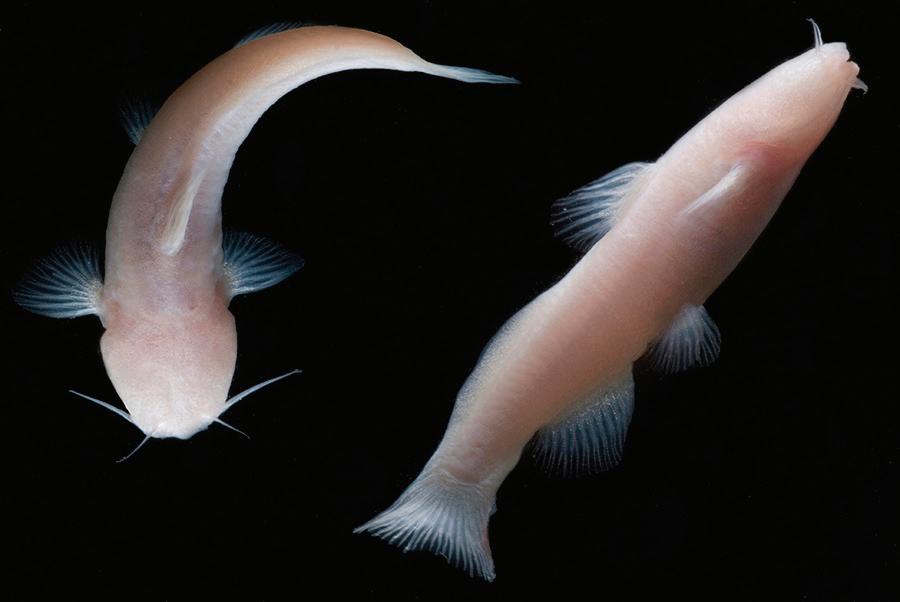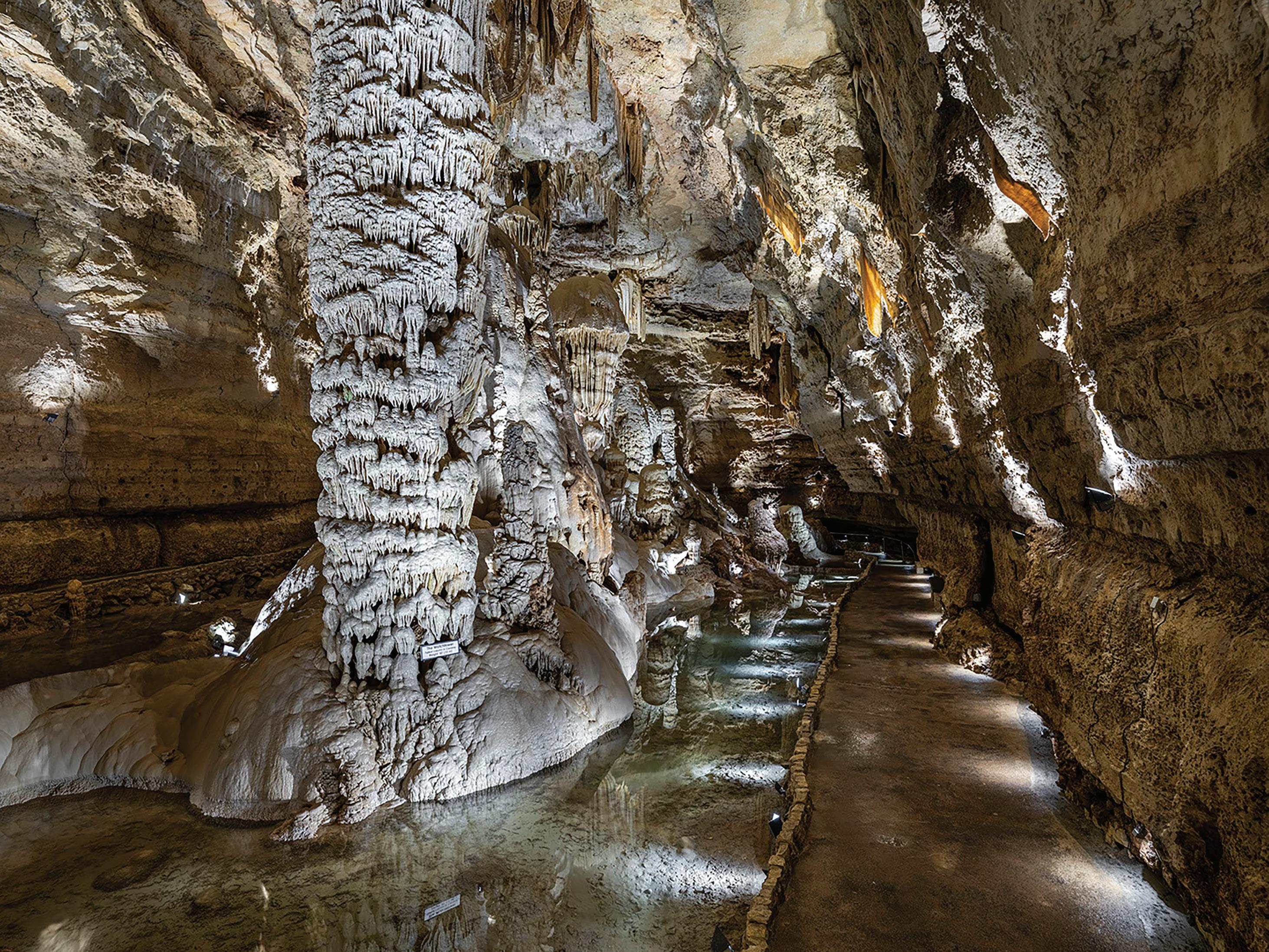Cave Critters



Caves in Texas are not all alike. Some caves have been formed by wind, some by water, some by movement of the earth, and some by a combination of those forces. The most common type of cave in our state are limestone caves, formed by both movement of the ground and water flowing from the surface and the dissolving away of the rock by rainwater over millions of years.
Rainwater does more than create the cave, or void. It also helps decorate a cave. Through a process called calcite deposition, rainwater travels down through layers of soil and rock and drips into the cave. As rainwater travels through the rock, it picks up a mineral from the limestone called calcite. When the water drips down, it leaves a small bit of calcite, and over time, those tiny deposits can create a formation. Formations created by this kind of process are called speleothems (pronounced SPE-leo-thems).
There are all kinds of speleothems, and they have fun names too! The most common are soda straws, which are hollow and thin. Then there are stalactites (which hold on tight to the ceiling) and stalagmites (which might reach the ceiling someday). Cave bacon looks like giant slices of bacon and hangs from the sides of a cave. Cave popcorn looks like freshly popped popcorn.


When you visit a cave, it is important to not touch any of the formations. The oil on our skin can destroy a formation, many of which continue to grow at a very slow pace. It is also important to pay close attention to what goes into natural areas around caves since chemicals can impact the cave and the creatures that live inside.

… that cave critters are similar to animals outside a cave, but they have adapted or changed to live in the darkness?
… that cave critters are often white or light in coloring because they do not need to be camouflaged in the dark?

… that Mexican blindcat catfish are one of three kinds of blind catfish in Texas?
… that there are three zones in a cave, and different critters live in each zone?
… that most cave critters are smaller than similar animals outside the cave?
… that the largest colony of mammals living together are found in Texas? Fifteen million Mexican free-tailed bats live in Bracken Cave outside of San Antonio!
(Eurycea waterlooensis)


Caves are home to all kinds of interesting animals. A lot of what you will find depends on how deep in the cave you go. At different depths in the cave, you will find different types of cave critters, including a few that look a lot like the wildlife you find outside a cave. The only difference is they have adapted – or changed – to live in a place that is completely dark.
Caves have three zones. The first zone is the Entrance Zone, where the opening of the cave meets the world above ground. In this area there is some sunshine, and some plants can grow. Plants that like shade can survive in this area, like ferns and moss. The temperature does not change as much in this area compared to outside the cave. This is because the cave entrance provides some shelter from wind which can make it feel colder and direct sunlight which can make it hotter.
Diverse animals live in the Entrance Zone, like raccoons or bears. In Texas many raccoons, who are nocturnal and awake at night, will make their home inside the entrance zone of a cave. In fact, at least one cave in Texas was discovered when a dog chased a raccoon, and it ran into a small entrance of a cave! The animals who live there and a little further inside the cave are called trogloxenes (pronounced tro-glowseens) or subtroglophiles (pronounced sub-trog-lo-files). Trogloxenes and subtroglophiles are also known as “cave guests.”





The second zone in a cave is called the Twilight Zone. This area is a little further back into the cave, and there is less light and no plants. The temperatures in this part of the cave do not change much year-round since the weather outside does not make it all the way into the cave. It is like having your front door open in your house – right near the door it might feel like it does outside, but the further into your house you move and away from the door you go, the less of the outside weather you feel. Animals who live in this zone do need moisture and coolness to survive, but they also need to leave the cave to eat. They usually leave at night.
Bats are one type of animal in this zone. The Cave myotis bat (Myotis velifer) is a bat that lives in several Texas caves. It has brown or black fur on its back and paler fur on

its belly area. It has short ears that are pointed and small eyes. Another bat common to Texas is the Mexican freetailed bat (Tadarida brasiliensis). Mexican free-tails migrate into our state in February after spending their winter months in Mexico where it is warmer. These bats have wider and narrower wings than the cave myotis bats, but otherwise they are pretty similar. More than 15 million Mexican free-tailed bats make their summer home in Bracken Cave, right outside San Antonio. That is the largest group of mammals living together in the world!
Another animal that lives in the Twilight Zone is a specific type of cricket – the cave cricket (family Rhaphidophoridae). They look a lot like regular crickets except for one thing. These crickets cannot chirp. This is a good thing since making noise could mean getting eaten by a predator. Cave crickets escape danger the same way as other crickets by jumping. Cave crickets sometimes leave the Twilight Zone of the cave at night to look for food, like fungus.
The third zone in a cave is called the Dark Zone. This area is further back in the cave, and there is absolutely no light at all. The temperature deep in the cave is constant – although caves around the world all have different


temperatures depending on the average temperature in their area. For example, in Texas, caves can be 70 degrees, but up north in Wisconsin they can be 50 degrees. Everything that lives in this deep area of the cave has had to adjust to life in total darkness.
There is still a lot of life deep in the cave! Animals that have adapted to life in the Dark Zone of a cave are called troglobites (prounounced tro-glow-bites). Toglobites include cave beetles, cave spiders, harvestmen, salamanders and cavefish.
Biologists have found tiny amphipods (tiny shrimp-like creatures) living in pools in Natural Bridge Caverns outside of San Antonio, Texas. These cave amphipods (Stygobromus russelli) have no eyes and are white. They survive by eating tiny bacteria in the pools.
One of the smallest creatures that lives in the cave is a springtail. These tiny creatures are about the size of a grain of sand. They live in wet places in the cave and live on tiny microbes and fungi. Springtails also have a special power. They do not have wings, but they can jump very far thanks to a fork-shaped tail-like part of their body. Usually, this tail is folded against their body, but if they need to escape, they release it and it helps them “spring” away. When they jump, it happens so fast you can only see it with a special high-speed camera.
Another creature that lives in the cave looks a lot like a spider but is not one. It is called a cave harvestman (Chinquipellobunus madlae), and it is similar in appearance to a daddy longlegs. They are not spiders because they cannot
the more famous salamanders in our state. It is endangered and lives in the aquifer around San Marcos, Texas. The Texas blind salamander has a keen sense of smell and can feel water pressure changes caused by tiny snails, shrimp and other creatures in the water.
There are also new finds deep in Texas caves including a type of blind catfish. This very rare eyeless catfish, the Mexican blindcat (Prietella phreatophila), which was only known to live in Mexico, was recently found in a cave near Del Rio, Texas. These blind, white catfish are one of three species of blind catfish in Texas.

Caves all around the state are being explored and more creatures are being discovered even today. Taking care of caves is very important since they hold so much of our drinking water, and the creatures that call caves home cannot live outside of these special places.
There are several ways to take care of caves. One is to protect the land above a cave. Since any pollution above ground can make its way into a cave, it is important to keep land and waterways clean. Making sure to only explore caves with experts is also important. Often people can bring in soil or germs that can harm the cave and the creatures inside it. For example, a disease that hurts bats called White-nose Syndrome can be brought into a cave by people who have visited another cave that already had the disease and never even realized it. That is why expert cave explorers follow rules to clean their equipment before exploring. The other way to save caves is to preserve land where there are caves so that nothing is built on top of them. Many large caves are part of state and national parks or have been saved by the landowners who preserve their beauty.
Trogloxenes and Subtroglophiles – Animals that live in a cave but come outside, usually at night.






make silk or venom, and they have one single body instead of a head and body like a regular spider. Cave harvestmen have no eyes and are typically white or a very light yelloworange. They look small to us, but they are big predators in the cave, going after the small bugs as well as bacteria.

Deep in the cave there are also salamanders, an amphibian with a slender body and short limbs as well as a tail. The Texas blind salamander (Eurycea rathbuni) is one of
Troglobite – An animal species that lives only underground, like in a cave.
Amphipods – A type of crustacean that lives in cave pools that looks like a shrimp.
Unscramble the word/s at the end of each line to find the missing word/s.
Cave formations are called ____________ and there are many types. TSLEOPMEHSE
Bats live in a special zone of the cave called the ______________ zone. GTWILHIT
One of the most common formations in a cave is called a __________ __________. AOSD WRAST
Cave ______________ cannot chirp. KETCIRSC
Mexican Blindcats are new cave ___________ found in ____________. IFCHAST XTASE
When rainwater travels through the rock, it picks up a mineral from the _____________ called calcite. ILMSOETNE
Many animals that live in caves are __________________. OCNRULTAN
List three ways you can help conserve caves.
1. _______________________________________________
2. _______________________________________________
3. _______________________________________________
Discovery Trunks
* 2-week reservations
* Seven wildlife topics
* Hands-on materials and lessons
* TEKS aligned for Grades K-8
Stewarding Texas

* 40 lessons about land stewardship and conservation
* Available online and in every Discovery Trunk
* TEKS aligned for Grades K-12
Youth Videoconferencing
* 45 minute live programs
* Live animals
* Interactive questions and worksheets
* Designed for Grades 1-6
Wildlife by Design
* Classroom Presentations
* 30-60 minutes in length
* Hands-on, inquiry-based learning
* TEKS aligned for Grades K-8
Educator Workshops
* Provides hands-on training and lessons for educators
* Grades K-8
* 6 hours of CPE credits
On-demand Webinars
* 13-25 minute programs
* Available anytime
* Interactive questions and worksheets
* TEKS aligned for Grades K-8
Critter Connections
To receive a one-year subscription of Critter Connections go to:
https://www.texas-wildlife.org/critter-connections-magazine/ Here you can also find former issues and read-along videos.

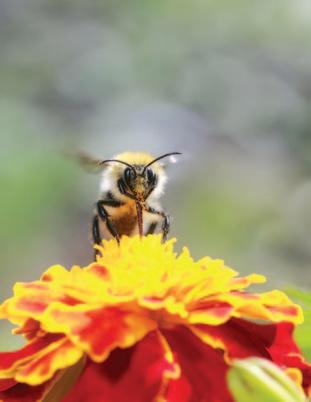



www.texas-wildlife.org
TWA is a membership-based, non-profit organization whose goal is to educate all people, especially the youth of Texas about conservation, management and stewardship of wildlife and habitat on private land.
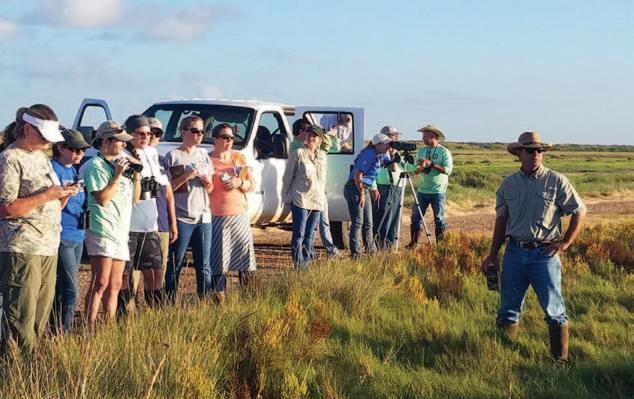

All education programs are made possible through memberships, grants and donations. Learn more about the levels of membership as well as the educational programs TWA offers on our website. All membership levels include a one-year subscription to the TWA monthly Texas Wildlife magazine.

Membership Levels: `

We’re
